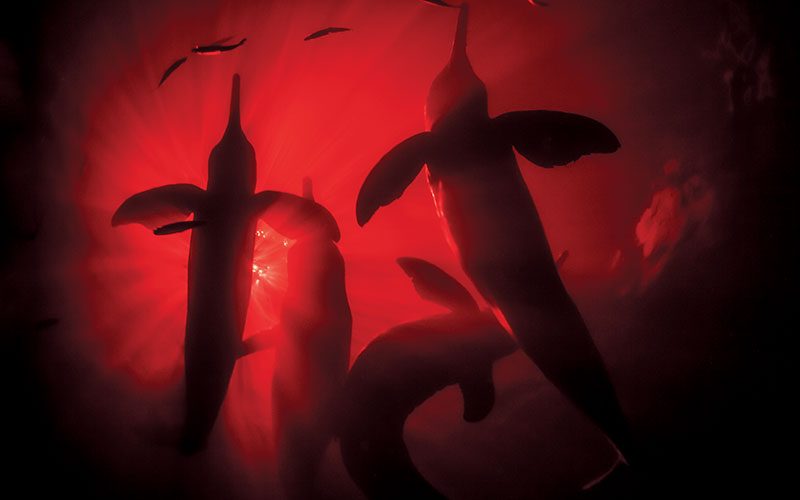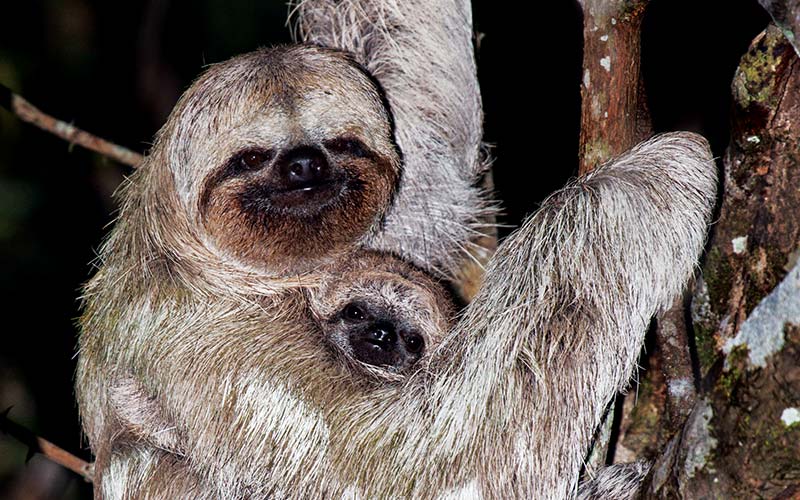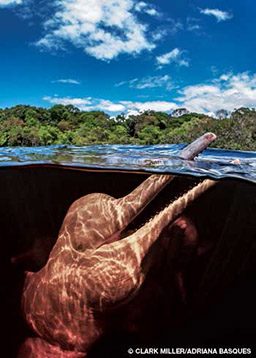Larger than the continental United States and the fifth-largest country on earth, Brazil is living proof that size matters. Both predators and prey reach enormous proportions, and strangeness abounds. Snakes nearly as big around as office water-cooler jugs hunt rodents the size of pigs. Pink dolphins swim in tea-stained rivers where armored, 400-pound, bony-tongued fish can breathe air, and caimans are as common as fruit on jabuticaba trees.
I embarked on my first major expedition into the Brazilian wilderness in May 2012 — late in the fall there. The three-week adventure covered more than 1,200 miles and encompassed the flooded Amazon basin near Manaus, the northern reaches of Mato Grosso and the colossal expanse of the Pantanal, a vast tropical wetland. Largely unexplored, these remote regions are replete with unexpected hazards and home to an immeasurably diverse array of wildlife. The ambitious route photographer Adriana Basques mapped out for us required four separate guides, each seasoned by a lifetime of experience. Going it alone could have easily proven fatal. We were optimistic that although the trip would be logistically challenging, it would prove photographically rewarding.

The Amazon
Manaus, founded in 1669, is characterized by cobblestone streets lined with fruit trees and the famous Amazon Theatre opera house. It’s poised near the equator along the “Meeting of the Waters,” where the dark Rio Negro and the sandy Rio Solimões (a name often given to this stretch of the Amazon) come together. The two rivers run side by side for four miles before finally mixing together to form one of Brazil’s most majestic sights, nearly 1,000 miles upstream of the Atlantic Ocean.
Once acclaimed as the rubber capital of the world and with wealth rivaling that of Paris, Manaus is a city with a dark past. Indigenous tribes were subject to enslavement and all manner of European brutality in a continuing effort to keep the latex flowing. Eventually, malaria and yellow fever crippled the population, making little distinction between rich and poor. Manaus’ rubber boom died in 1913, and 140 of the town’s finest mansions were sold at auction amid a mass exodus. Today, the opera house, with its frescoes and domed, mosaic roof, stands in testament to the suffering and the naiveté of the colonialists’ attempts to marshal the 19th-century Amazon — where a mosquito or a glass of water could kill you — into an expression of Europe.
Today Manaus is a foreign trade zone for electronics, oil refining, lumber and fishing. As the Amazon River snakes 4,000 miles from its source in Peru to the Atlantic Ocean, it provides between 30,000 and 50,000 tons of freshwater fish for market, many of which arrive without names, with tiger-striped tails or eyes that glitter like gold. These once-abundant fish have become more difficult to find as fleets continue to expand and the resource is strained even further. Recent laws such as the banning of purse seining on the lower Amazon are beginning to make a difference in areas where fishing regulations are few. Many of the large fish with the choicest meat — silvery pirarucu, tambaqui and ruby-eyed tucunare — are now too expensive for the average consumer and have been replaced on menus with various species of catfish. Some of the region’s catfish are so large they could swallow a person whole. Others are plated in black armor, sport long whiskers like Chinese emperors or carry poison-tipped spines.

In the last two years taxonomists in Brazil named more species of fish than in any other country, claims Luiz Rocha, curator of ichthyology at the California Academy of Sciences in San Francisco. “If you want to name a new fish in the Amazon,” he said, “it seems all you need is a net.” Scientists estimate that more than 2,500 species of fish can be found in the Amazon and its tributaries — more than in any other river in the world.
We arrived at our hotel-on-stilts along Rio Ariau two hours from Manaus. The hotel was a random array of buildings perched 90 feet above the river, which were connected by a spider network of walkways that was now underwater, making our bungalow accessible by boat alone. In 2012 flooding in the Amazon was higher than ever recorded. It was supposed to be the dry season, and we were floating in the treetops.
Pink River Dolphins
Our guide made arrangements at a location where pink river dolphins, known locally as boto, had recently been sighted. Pink river dolphins (Inia geoffrensis) can be found throughout the rivers of the Amazon basin, which in addition to Brazil includes parts of Colombia, Peru, Bolivia, Ecuador, Guyana and Venezuela. The tea-stained waters of the flooded forests provide them a near-boundless range for foraging during the wet season. They feed on more than 50 species of fish as well as turtles and crabs. Their small, beady and underdeveloped eyes offer little visibility in the dark water, so these animals evolved highly refined sonar capabilities for navigation and hunting, becoming masters of their murky environs.

With their bulbous, melonlike foreheads and long, tubular mouths, pink river dolphins are distinctly unlike other dolphins. They have no prominent dorsal fin but large winglike flippers. Oddly, botos can appear almost humanlike. Local inhabitants continue to believe the dolphins are consummate shape-shifters capable of morphing into handsome men wearing white clothing and hats who have the seductive power to entice young women to fall in love with them. Unexpected pregnancies in young women are often blamed on the botos. Their bodies are commonly raked with scars inflicted by the sharp teeth of other botos. They can weigh more than 200 pounds and be up to eight feet long.
Not all pink dolphins are pink. The young start out gray and become pinker as they mature, and botos often flush pink when they become excited. Scientists admit that little more is understood today about their behavior than was a hundred years ago. They do not migrate, but little is known about where they go during the dry season, when the breeding season occurs or whether there is one. Their anatomy is understood through autopsies, but most of their life cycle remains a mystery.
Loaded down with fish, we crisscrossed canals through treetops and across what looked like an ocean disguised as a river to spend the next four days above the watery world of Encante seeking favor with the boto. With a robust bom dia (Portuguese for “good morning”) we arrived at a makeshift dock owned by a local fisherman whose wife made fried fish that would have been the envy of celebrity chefs. It was clear from the start that this visit would be a special one.
Each day the infectious familiarity of friendship spread to all of us in the water. On day three, in a symphony of clicks, bubble bursts and affectionate nudges, I was deemed a special guest by four botos who chased and fought with one another over who would be my aquatic companion. They circled me boisterously, coveting my attention. As the light waned on our return to our home on stilts, my thoughts turned to the challenges these congenial beings will face. These flagship animals are thought to be in decline due to hunting, fishing, competition with fisherman and the notion that eating their flesh leads to enhanced sexual ability. Like performers at the Amazon Theatre, the boto put on their finest show for us — a plea, perhaps, for their continued existence. The “Fight Against the Extermination of the Amazon Pink River Dolphin” has become a rallying cry to promote these animals’ continuing survival (see “Learn More”).
Pirarucu

Before we left the Amazon, we learned about a location at the southern edge of the region that had pools of clear water where we would find one of most prehistoric fish on earth, the pirarucu (Arapaima gigas). With eyes on the tops of their heads, these armor-scaled, bony-tongued fish evolved to breathe air, which gives them an advantage in the hypoxic conditions of the Amazon, especially during the dry season. These fast-growing fish can reach 350 pounds in only five years. Many of the largest specimens are gone, having been fished out to satisfy the appetites of those who consider its flesh a delicacy. Still, tremendous monsters continue to live in some of the deepest and most remote reaches of the rivers.
When we arrived, the temperature had dropped to nearly 40°F — unheard of in those parts during that time of year. We awoke looking at our breath. As the skies cleared and temperatures warmed, we could see the enormous fish basking close to the surface in the shallow waters of a lake. Persuading one to cooperate with a camera wasn’t easy, as silt blew up off the bottom with every mistaken move. By midday they were still cautious but a little more comfortable with our presence, and we could approach within inches of their torpedo-shaped bodies.
The Pantanal
We flew to Cuiabá with the hope of photographing the animals of the Pantanal, a vast tropical wetland covering between 54,000 and 81,000 square miles. A single dusty and poorly maintained dirt road with 120 wooden bridges, the Transpantaneira highway (MT-060) cuts through the state of Mato Grosso across the Pantanal. We traveled there for caimans, jaguars and endangered giant river otters, but in retrospect it was an embarrassingly short list in light of the plethora of wildlife we would come to know. Our guide, a renowned ornithologist who literally wrote the authoritative book on birds of the Pantanal, spent the next week with us.

Viewing wildlife in the Pantanal is like taking a spaceship back in time. The enormity of the wetland is mind-blowing. The huge Rio Cuiaba divides into three other rivers that break off into a maze of tributaries stretching back into the wetlands for more than 100 miles. Often we would find ourselves 30 miles or more into the wetlands, virtually lost in an Oz of greenery as far as the eye could see. We felt very remote in our little metal boat, though we were accompanied by our constant friends, the mosquitoes. This is the domain of Panthera onca, the jaguar. We spotted caiman and capybara at nearly every turn of the river — both important food sources to the third largest cat on earth. Onça can weigh up to 250 pounds and are stealthy predators that are difficult to locate in the vast reaches of this, their most substantial remaining holdout on the planet.
The sheer delight of watching nature on this scale is a nagging reminder of how much wilderness has been lost in exchange for our current way of life. We seldom realize the price of human intervention until we experience an undisturbed corner of the world like the Pantanal. Wildlife flourishes everywhere, and rarely was there an idle moment when our attention wasn’t called to something magnificent.
Coming to a bend in the river we happened upon a family of giant river otters (Pteronura brasiliensis), also known as ariranha. As if in response to an alarm, these rambunctious swimmers (and largest members of the weasel family) put on an impromptu Broadway show. Hunting, catching and eating fish as we drifted down stream with them, they were ever on the move. They were territorial, argumentative rulers of their domain, and they were endlessly fascinating to watch. Streamlined and nearly five feet long, their webbed feet and winglike tails give them power and grace in the water to rival that of dolphins.
During the dry season most wildlife is drawn to the banks of the river; caiman, in particular, travel long distances to aggregate by the tens of thousands. Capybaras cautiously skirt the waterways in attempts to avoid onças, anacondas and the caimans. As the most sought-after entree on the menu, only overwhelming thirst is enough to lead the capybaras to the danger-rife riverbanks.
Each day we set out in search of onça, but we never seemed to be at the right place at the right time. We spotted a young juvenile along the banks of the Cuiaba River catching the sunset one evening, but upon our approach he became uncomfortable with our presence and dissolved into the darkness of the forest. We nearly left the next morning, but Ken didn’t even get a glimpse of the jaguar the previous evening, so we decided to give it one more day. A short distance upriver of our camp, a guide from another company had been tracking an onça for nearly an hour in his boat as he drifted down river toward us. He graciously pointed out the big cat that was furtively making its way along the bank behind the cover of some brush. As if taking a curtain call, it entered a small clearing less than 20 yards away and lay down on the riverbank to gather the warmth of the morning sunshine. Whether out of vanity or curiosity, it posed contentedly as the paparazzi fired away.

Bonito
We flew on to Mato Grosso do Sul under ominous skies to meet up with our guides Daniel and Juca to explore the region of Bonito. Our first stop was the Aquarium Natural, a stunningly clear body of fresh water teeming with dourado, piraputanga, pacu and various other colorful tropical fish. The cool water of the rivers in this region, which keeps out the piranhas, is clarified by a calcium-rich bedrock formation known as karst. This formation acts as a natural filtration system and is rich in nutrients, allowing fish to proliferate.
The Rio Formoso and the giant green anaconda (Eunectes murinus), or sucuri, were the true objects of our search. The weather had turned dire for the last crew of photographers to visit the area; they spent the previous week painfully searching in the rain. Again, it was the dry season, and the rain should have stopped many weeks before. When we arrived, the weather cleared, and the temperature warmed — both factors would improve our chances of an encounter. As exothermic reptiles, anacondas avoid the shallow river when the water temperature dips, but our guides were seasoned experts at finding the snakes in this part of Bonito and were confident the conditions were favorable.

Feeling the excitement, Brandon and I prepared to snorkel down the river, paying close attention to the banks, where both anacondas and their prey would most likely be. The snakes are here this time of year to mate and feed upon capybaras and caimans, the same prey jaguars seek. We swam a little way behind our boat until Juca, our guide, finally spotted a large 24-foot female along the water’s edge. We eagerly assembled our scuba gear as Juca gently coaxed the behemoth into the water. The snakes are big enough on land and terrifyingly enormous underwater. Education always trumps ignorance, though, and there are no recorded instances of anacondas attacking humans. We were still respectful, of course, and she cautiously accepted our presence. Her head — which was the size of my dome — was at times mere inches from my face. It was an experience of graceful beauty, culminating in the snake deftly maneuvering her large body up the embankment and back into the recesses of the marshy saw grass.

We spent our last days visiting the panoramic Buraco das Araras, a colossal red-rock sinkhole 400 feet deep and more than a quarter mile across. Known as a doline (a collapsed cave), the site is a popular nesting place for hundreds of scarlet macaws, parrots and ibises.
The days and weeks seemed to melt into one single, circular experience. Each of us came away with something special, including photographs and artistic inspiration. One member of our group, Melissa, produced a giant mosaic of a green anaconda. Though we longed for the road to continue and the river to wind farther along, it was now time to say tchau. I was sad about having to leave with so much left to explore. May I never see it all.
© Alert Diver — Q2 Spring 2013